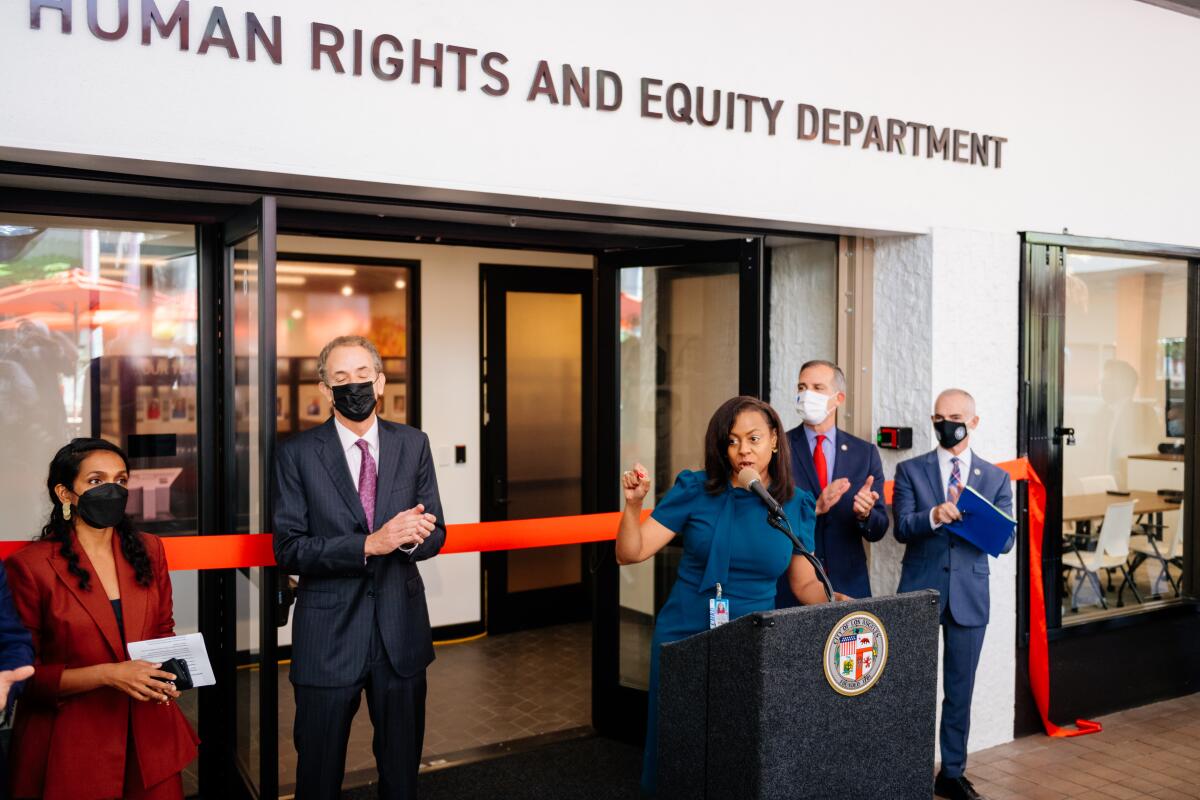Are you the victim of discrimination? The city of L.A. may now be able to help

- Share via
To directly support Angelenos who face discrimination, the city of Los Angeles’ Civil + Human Rights and Equity Department has launched a unit to investigate complaints about discrimination by employers, landlords and businesses.
City residents whose civil rights are violated already had the ability to file complaints with state and federal civil rights authorities, such as the U.S. Equal Employment Opportunity Commission. But Capri Maddox, executive director of the new L.A. Civil Rights division, said her group will help Angelenos avoid the significant backlogs they might encounter at higher levels of government.
In particular, Maddox said, the division is a response to “our community-based organizations like the Black Worker Center, the UCLA [Labor] Center and others that stepped up to say that they wanted to see local enforcement in areas of commerce, education, employment and housing in the private sector,” Maddox said.
“We seem to miss some of the places and spaces where people are discriminated against,” she continued.
Violence, hate crimes and hate speech, she said, can be committed by managers, landlords or business owners. “So we want to be intentional in the city of Los Angeles to really say that ‘hate has no home in this city,’” Maddox said.
If someone has faced discrimination in L.A., they can file a complaint with the division and begin the process of seeking redress for their grievances. Here are some of the details.
How do you file a complaint?
Before you submit a complaint, know that filing one doesn’t prevent you from pursuing any other available criminal, civil or other remedies.
You can file a complaint by visiting the L.A. Civil Rights website, by emailing [email protected], or by calling (213) 978-1845. Joumana Silyan-Saba, the division’s director of policy and enforcement, said the division will check to see whether the alleged discrimination meets four criteria:
- It occurred within the city of Los Angeles.
- Less than three years passed before the intake form was submitted.
- The alleged discrimination occurred in the private sector (affecting commerce, education, employment or housing). The division does not have the authority to investigate complaints against public entities, including other city departments.
- The alleged discrimination targeted someone in a protected class (that includes discrimination on the basis of race, gender, disability, citizenship status or religion).
Filing a complaint is a difficult first step.
“You can have situations where people are going to come into our offices with all of their written documents in a plastic bag, and they’ll be crying, or they may speak a language other than English, or they may not really understand how the process works at all,” Maddox said.
Maddox and Silyan-Saba said the intake and investigations team try to keep empathy and compassion at the forefront of this process.
Silyan-Saba said her team recognizes that those who are reaching out to the division are also experiencing trauma, so they’re equipped to help address that aspect as well.
The discrimination enforcement flowchart from the City of L.A.’s Civil + Human Rights and Equity Department.
Will my identity be revealed?
The complaint intake (where you provide basic contact information) and review processes are confidential. But once the investigator moves into the enforcement phase, Silyan-Saba said, the process becomes public.
For example, when the division files a notice of violation, it’s a public document that names the complainant and the person accused of discrimination (the respondent). If the respondent wants to have an administrative hearing, that’s a public process as well.
If you’re worried about retaliation for filing a complaint, Maddox said, retaliation against any person for exercising rights that are protected by the city of Los Angeles’ civil and human rights ordinance is prohibited and punishable as a misdemeanor.
What happens after I file a complaint?
Once it’s determined that the criteria are met, the investigation phase begins. The investigator will work with the complainant to obtain any additional documents or information needed. The investigator will also go over the process with the complainant.
The investigator will go through the same process with the respondent and ask the individual for any relevant records. This portion of the investigation could require site visits.
The division has subpoena power, so investigators can compel people to provide documents and other evidence.
If it finds that discrimination has occurred, the division will consult with the complainant and issue a notice of violation. The respondent will then have 15 days to ask for an administrative review.
If the respondent requests a hearing, a hearing officer will review the case and uphold all, some or none of the notice of violation and penalties. The process will end there unless the respondent or complainant can show some abuse of discretion by the hearing officer. If so, the case will go to the city’s Commission on Civil Rights, which will review the case once more. The commission has the final say, per the city ordinance.
The agency can encourage the complainant and the respondent to negotiate a settlement, although it’s not required. It can also refer the two sides to a mediator.
What are the possible outcomes?
First and foremost, when you go to the division for help and file a complaint, Silyan-Saba said, there’s recognition of the wrong that may have been done to you.
Aside from validation, there are also potentially significant consequences for the respondent if the division finds that discrimination has occurred.
Based on the results of the investigation, the division may impose administrative and compensatory penalties of up to $250,000. It can also order the respondent to take corrective actions, such as undergoing training, posting signs or updating policies. The corrective actions are determined on a case-by-case basis.
If you file a complaint that doesn’t meet the four criteria, the division will provide referrals to other community organizations, government agencies or legal organizations that can provide legal support.
If your complaint meets the four criteria but investigators determine that the practices are not discriminatory, the division will refer the case to another organization that can help you.
And if your complaint is not within the scope of its authority, the division will refer the matter to state or federal civil rights authorities.
“So even if something doesn’t move forward to either settlement or notice of violation, we will do everything we possibly can to make sure that the individuals reaching out to us are finding some sort of a resource that we can point them to,” Silyan-Saba said.
How did the division come about?
The division and its discrimination complaint process have been eight years in the making, according to Lola Smallwood Cuevas, a founding director of the Black Worker Center and project director of the UCLA Labor Center. Those two organizations, along with the Instituto de Educación Popular del Sur de California and a multiracial coalition of workers and community organizers, pushed for a local enforcement agency because “residents wanted this kind of division,” Cuevas said.
Advocates believed that state and federal agencies weren’t doing enough to stop discrimination against workers and community members, she said. Their view, she said, was that “we need a more robust, more active boots-on-the-ground strategy for these protections.”
“There needed to be a local department that residents could have more say-so [in] and access to in terms of how those rights get protected,” Cuevas said. In addition, having a local agency would “ensure that at a local level there’s a record and a monitoring of where this discrimination is happening, how it’s happening, and that we are developing proactive policies to address it and to hold bad actors accountable,” Cuevas said.
San Francisco and San Diego already have agencies that investigate discrimination complaints on a local level. Now that L.A. has one, Cuevas said, it could become a model for statewide partnerships “to create a seamless enforcement strategy that protects the [city’s] diversity and ensures a diversity in our housing and in our workplaces.”
About The Times Utility Journalism Team
This article is from The Times’ Utility Journalism Team. Our mission is to be essential to the lives of Southern Californians by publishing information that solves problems, answers questions and helps with decision making. We serve audiences in and around Los Angeles — including current Times subscribers and diverse communities that haven’t historically had their needs met by our coverage.
How can we be useful to you and your community? Email utility (at) latimes.com or one of our journalists: Jon Healey, Ada Tseng, Jessica Roy and Karen Garcia.
More to Read
Sign up for Essential California
The most important California stories and recommendations in your inbox every morning.
You may occasionally receive promotional content from the Los Angeles Times.











